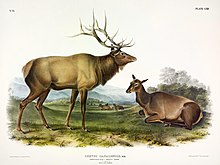
A deer or true deer is a hoofed ruminant ungulate of the family Cervidae. It is divided into subfamilies Cervinae and Capreolinae. Male deer of almost all species, as well as female reindeer, grow and shed new antlers each year. These antlers are bony extensions of the skull and are often used for combat between males.

The sika deer, also known as the Northernspotted deer or the Japanese deer, is a species of deer native to much of East Asia and introduced to other parts of the world. Previously found from northern Vietnam in the south to the Russian Far East in the north, it is an uncommon species that has been extirpated in most areas of its native range, except in Japan, where it is overabundant and present in very large numbers.
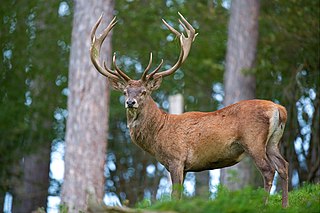
The red deer is one of the largest deer species. A male red deer is called a stag or hart, and a female is called a doe or hind. The red deer inhabits most of Europe, the Caucasus Mountains region, Anatolia, Iran, and parts of western Asia. It also inhabits the Atlas Mountains of Northern Africa; being the only living species of deer to inhabit Africa. Red deer have been introduced to other areas, including Australia, New Zealand, the United States, Canada, Peru, Uruguay, Chile and Argentina. In many parts of the world, the meat (venison) from red deer is used as a food source.

The Roosevelt elk, also known commonly as the Olympic elk and Roosevelt's wapiti, is the largest of the four surviving subspecies of elk in North America by body mass. Mature bulls weigh from 700 to 1,200 lb. with very rare large bulls weighing more. Its geographic range includes temperate rainforests of the Pacific Northwest including parts of northern California. It was introduced to Alaska's Afognak, Kodiak, and Raspberry Islands in 1928 and reintroduced to British Columbia's Sunshine Coast from Vancouver Island in 1986.
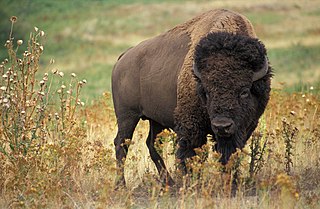
The Plains bison is one of two subspecies/ecotypes of the American bison, the other being the wood bison. A natural population of Plains bison survives in Yellowstone National Park and multiple smaller reintroduced herds of bison in many places in the United States as well as southern portions of the Canadian Prairies.
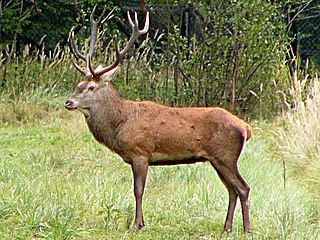
Cervus is a genus of deer that primarily are native to Eurasia, although one species occurs in northern Africa and another in North America. In addition to the species presently placed in this genus, it has included a whole range of other species now commonly placed in other genera. Additionally, the species-level taxonomy is in a state of flux.
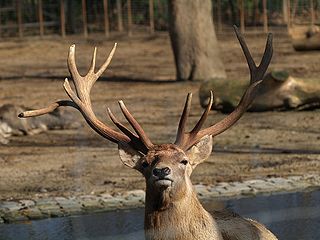
The Bactrian deer, also called the Bukhara deer, Bokhara deer, or Bactrian wapiti, is a lowland subspecies of Central Asian red deer native to Central Asia. It is similar in ecology to the related Yarkand deer in that it occupies riparian corridors surrounded by deserts. The subspecies are separated from one another by the Tian Shan Mountains and probably form a primordial subgroup of the red deer.
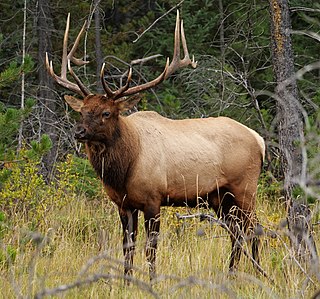
The elk, or wapiti, is the second largest species within the deer family, Cervidae, and one of the largest terrestrial mammals in its native range of North America and Central and East Asia. The word "elk" originally referred to the European variety of the moose, Alces alces, but was transferred to Cervus canadensis by North American colonists. The name "wapiti" derives from a Shawnee and Cree word meaning "white rump" for the distinctive light fur in the rear region, just like the Bighorn Sheep.

The tule elk is a subspecies of elk found only in California, ranging from the grasslands and marshlands of the Central Valley to the grassy hills on the coast. The subspecies name derives from the tule, a species of sedge native to freshwater marshes on which the tule elk feeds. When the Europeans first arrived, an estimated 500,000 tule elk roamed these regions, but by 1870 they were thought to be extirpated. However, in 1874–1875 a single breeding pair was discovered in the tule marshes of Buena Vista Lake in the southern San Joaquin Valley. Conservation measures were taken to protect the species in the 1970s. Today, the wild population exceeds 4,000. Tule elk can reliably be found in Carrizo Plain National Monument, Point Reyes National Seashore, portions of the Owens Valley from Lone Pine to Bishop, on Coyote Ridge in Santa Clara Valley, San Jose, California and in Pacheco State Park and areas surrounding San Luis Reservoir near Los Banos, California.
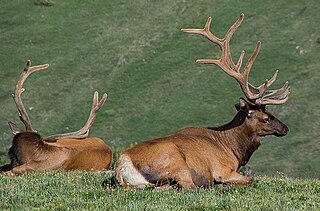
The Rocky Mountain elk is a subspecies of elk found in the Rocky Mountains and adjacent ranges of Western North America.

The Manitoban elk is a subspecies of elk found in the Midwestern United States and southern regions of the Canadian Prairies. In 2001–2002, a breeding population of 52 Manitoban elk was also introduced into the Cataloochee valley of the Great Smoky Mountains National Park in North Carolina to replace a population of Eastern elk which had gone extinct over 100 years prior. As of 2021, the population has grown to 150-200 individuals and has expanded their range outside of their initial protected region. In 2016, one of the elk from the North Carolina herd was spotted in South Carolina, the first time an elk had been seen in that state since the late 1700s.
The Merriam's elk is an extinct subspecies of elk once found in the arid lands of the southwestern United States, as well as in Mexico. From the first New World arrival of Europeans, unregulated hunting, rapid growth of farms and ranches, and uncontrolled livestock grazing had driven the subspecies into extinction. Actual records on wildlife management were not reliably maintained until the late 19th century; the population of Merriam’s elk was experiencing notable decline by the beginning of the 20th century, with the (approximate) year of extinction being 1906.

The West Virginia State Wildlife Center is a zoological park in French Creek, West Virginia. Operated by the West Virginia Division of Natural Resources, the Wildlife Center displays many of West Virginia's wildlife, including both native and introduced species. A few of the animals at the Wildlife Center were once found naturally in West Virginia, but were extirpated by the early 1900s.

The ecology of the Rocky Mountains is diverse due to the effects of a variety of environmental factors. The Rocky Mountains are the major mountain range in western North America, running from the far north of British Columbia in Canada to New Mexico in the southwestern United States, climbing from the Great Plains at or below 1,800 feet (550 m) to peaks of over 14,000 feet (4,300 m). Temperature and rainfall varies greatly also and thus the Rockies are home to a mixture of habitats including the alpine, subalpine and boreal habitats of the Northern Rocky Mountains in British Columbia and Alberta, the coniferous forests of Montana and Idaho, the wetlands and prairie where the Rockies meet the plains, a different mix of conifers on the Yellowstone Plateau in Wyoming, the montane forests of Utah, and in the high Rockies of Colorado and New Mexico, and finally the alpine tundra of the highest elevations.

The South Central Rockies forests is a temperate coniferous forest ecoregion of the United States located mainly in Wyoming, Idaho, and Montana. It has a considerably drier climate than the North Central Rockies forest.

The Yellowstone bison herd roams the Greater Yellowstone Ecosystem. The bison herd is probably the oldest and largest public bison herd in the United States, estimated in 2020 to comprise 4,800 bison. The bison are American bison of the Plains bison subspecies. Yellowstone National Park may be the only location in the United States where free-ranging bison were never extirpated, since they continued to exist in the wild and were not reintroduced.
The Henry Mountains bison herd, numbering 250 to 400 American bison, is one of only four free-roaming bison herds on public lands in North America. The other three herds are the Yellowstone bison herd which was the ancestral herd for the Henry Mountains animals, the Wind Cave bison herd in South Dakota and the herd on Elk Island in Alberta, Canada.

The Wind Cave bison herd is a herd of 250–400 American bison in Wind Cave National Park, South Dakota, United States. As an active participant in the conservation of American bison, it is believed to be one of only seven free-roaming and genetically pure herds on public lands in North America. The other six herds are in Yellowstone Park, Theodore Roosevelt National Park, Henry Mountains, Blue Mounds State Park (Minnesota), Minneopa State Park (Minnesota), and Elk Island National Park. The Wind Cave herd are of the Plains bison subspecies.
